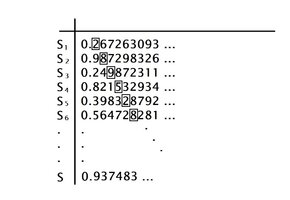This is why I ignored this. My understanding is that the rule applies to the construction of the enumeration S1, S2, S3, .... Not to the creation of the "new number" S from what is an arbitrary enumeration. You need two rules for that. In this example they are:
- If Sn(n) is not 3, then S(n)=3.
- If Sn(n)=3, then S(n)=????? . You don't specify.
Is Sn(n) the nth number listed, and S(n) the number that cannot be listed?
If the above is correct, then I want Sn(n) to not equal 3, and S(n) to always equal 3 (with both n's being equal).
The problem is that you don't get for control the Sn. Some digits that you apply a diagonalizing rule to will be 3s - for example, if there is an Sn that already is 1/3.
But this still doesn't make sense. So maybe of you explain what "the rule is not 3" means? What does it apply to?
I want to control what S(n) equals. I want it to be 0.33333 ....
Last edited:

